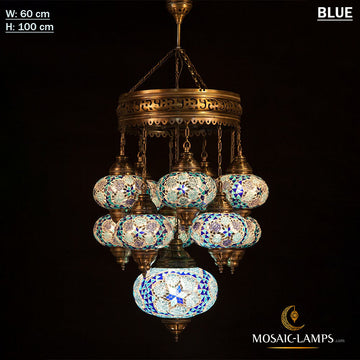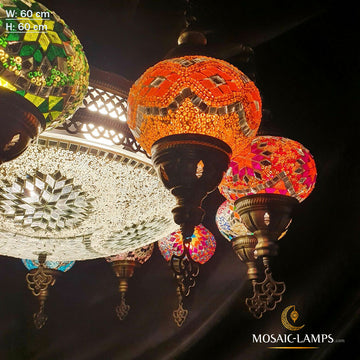Chandeliers - 11-15 Globe
- Featured
- Best selling
- Alphabetically, A-Z
- Alphabetically, Z-A
- Price, low to high
- Price, high to low
- Date, old to new
- Date, new to old
Our numerous globe chandeliers are a unique type of lighting fixture. The number of orbs can vary from 10 to 15 spheres, depending on your preference. While 10-11 globe chandeliers offer a more tidy and simple look, our 15 globe chandeliers provide a much more glamorous and dramatic look. We make each chandelier from various materials such as crystal, metal, mosaic, and more. To add light and visual interest to your space, you can use our handmade chandeliers in multiple settings, including dining rooms, living rooms, and entryways. Also, We manufacture unique lamps with CE, TÜV International Electrical Certificate quality.
Tips: At our company, customer safety and satisfaction are our top priorities. That's why our sphere chandeliers undergo rigorous testing to ensure they meet the electrical standards of multiple countries, including the United States, Canada, the European Union, the United Kingdom, Australia, New Zealand, and Japan. Whether you're in the US and Canada with a standard voltage of 110 V or in Japan and other parts of the world with a standard voltage of 220 V, our chandeliers are designed to work seamlessly in any setting. We take the extra steps to ensure that our chandeliers not only enhance your space's aesthetic but also meet your country's safety standards.
What are the different types of garden lamps?
There are several types of garden lamps, each with a distinct design and purpose. Solar garden lamps are powered by the sun and are eco-friendly. LED garden lamps use less energy and last longer than traditional bulbs. Pathway lights guide visitors along your walkway, while spotlights and floodlights are used to highlight specific features in your garden. There are also decorative lamps like lanterns and fairy lights that can enhance the aesthetic appeal of your garden.
How can I install garden lamps?
Most garden lamps, especially solar and battery-operated types, are easy to install. They often come with stakes that can be inserted directly into the ground. Some may require mounting onto walls or trees, for which screws are usually provided. For wired lighting systems, professional installation may be necessary, as it involves handling electrical wires and may require careful planning for wire routing and safety measures.
Are solar garden lamps as effective as electric ones?
Solar garden lamps can be as effective as electric ones, but their performance largely depends on the amount of sunlight they receive. They need ample sunlight to charge during the day and then provide illumination at night. They are energy-efficient and environmentally friendly, but they might not provide as much light as electric lamps, especially during overcast or rainy days. On the other hand, electric lamps provide consistent lighting regardless of weather conditions, but they use more energy and require electrical wiring.
How can I maintain my garden lamps?
Maintenance of garden lamps mainly involves cleaning and changing the bulbs as needed. For solar lamps, it's important to clean the solar panels regularly to ensure they can effectively absorb sunlight. LED bulbs in electric lamps usually last a long time, but will need replacing when they burn out. Regular cleaning of the lamp fixtures also helps to maintain their appearance and light output.
What are some tips for positioning garden lamps?
The positioning of garden lamps depends on their purpose. Pathway lights should be placed along the sides of paths and driveways. Spotlights can be angled to highlight specific features like trees, statues, or walls. Floodlights can be used to illuminate larger areas, like patios. Consider using a combination of light types for the best effect. Also, be mindful of light pollution - aim to light your garden in a way that doesn't disturb your neighbors or local wildlife.











